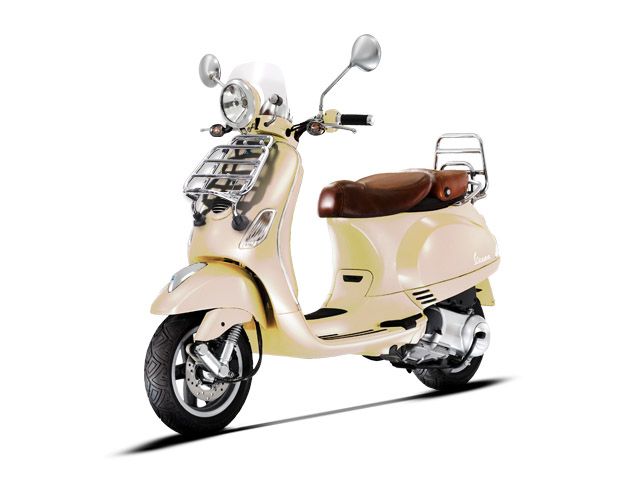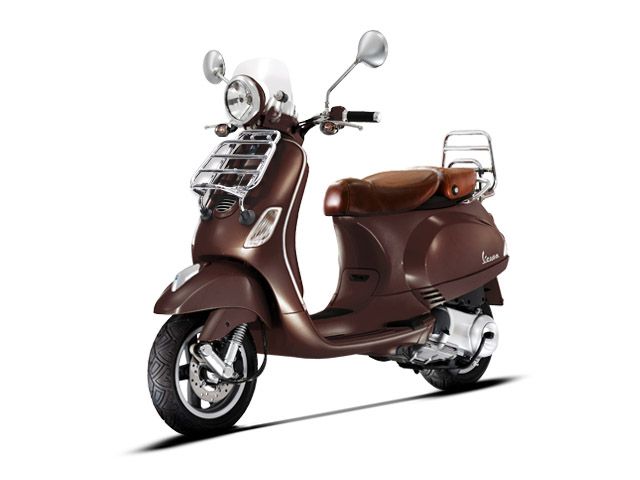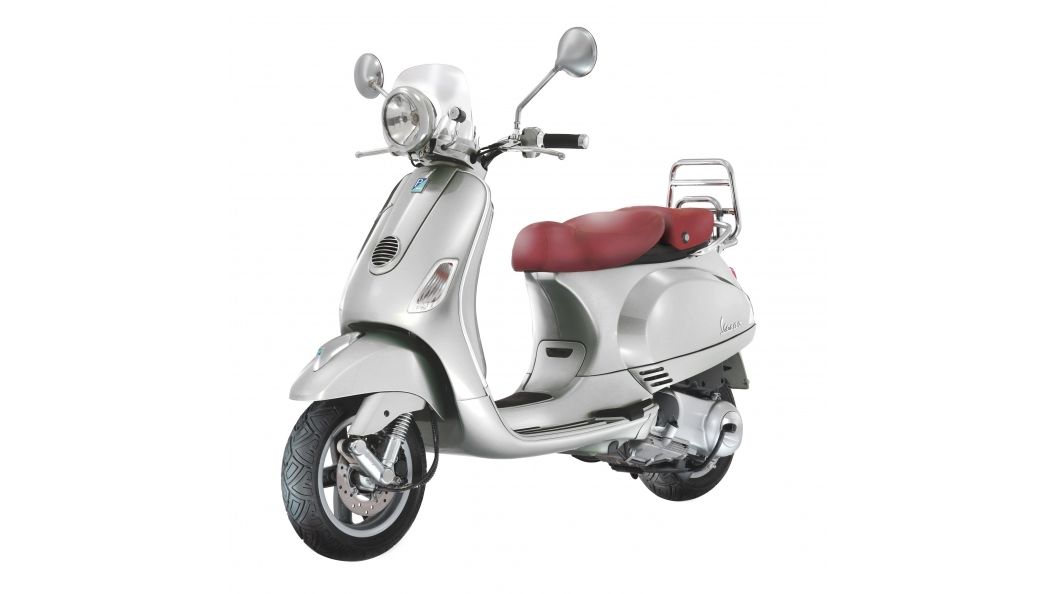Piaggio->ke2268 has been influencing scooter->ke2256 design ever since the end of the World War II when it shifted from airplane manufacturing to the two-wheel transportation sector in a bid to supply citizens of that war-torn country affordable transportation that could negotiate the shattered infrastructure.
The Vespa->ke2257 was born of this era, and reached the peak of its aesthetic quality during the '60s. It's funny, time keeps marching away, but folks still look to this era for inspiration and to serve as the “style standard” for a number of things, including scooter design and the LXV 150ie falls right into this mold. Piaggio didn't have to copy or invent anything or even reach to come up with the look; the company just borrowed design features from its own past and ran with it, albeit with a modern flair.
Continue reading for my review of the Vespa LXV 150ie.
2014 - 2015 Vespa LXV 150 IE
- Make: Array
- Model: 2014 - 2015 Vespa LXV 150 IE
- Engine/Motor: single-cylinder 4-stroke leader engine with catalytic converter
- [do not use] Vehicle Model: Array
Design
A hipster's wet dream, the Vespa LXV 150ie embodies everything that immediately pops to mind when you think of classic Italian scooters. A dual-skin leg shield houses the molded-in turn signals and shows a graceful, boomerang-like curve when viewed in profile. The step-through features a slight channel that interrupts the foot space a little bit side-to-side, but the scoop front on the under-seat storage area gives plenty of fore-and-aft play.
A molded saddle (and it is more of a proper saddle than a plain seat) cups and supports the rider's butt, and is joined by a P-pad to serve as a lockable lid for the storage compartment along with chrome grab rails and luggage rack. While it's difficult to qualify exactly what all gives the LXV 150ie its vibe, there can be no doubt that it does indeed enjoy plenty of it, and I for one am a fan.
Chassis
Rather than go with sheet metal body panels over an underframe, Vespa used the body panels themselves as the frame with a stressed-skin, monocoque load-bearing structure. While I'm not a fan of this style, I have to admit that it allows for a more compact overall structure and some interesting shapes, and Vespa seems to make it work quite well since they have used this construction method from the start.
The front fork is interesting indeed. Yes I said “fork,” as in singular. A one-sided assembly mounts the wheel and a coil-over shock on a trailing linkage for an unimpeded view of the front wheel from the right side of the bike, and the odd illusion of having a wheel with no visible means of support from that side.
A monoshock tucked away under the seat supports the rear of the scooter and tames the motion of the swing-mount motor unit. Vespa gets kudos for going with all-around disc brakes and shunning the ubiquitous drum brakes that somehow will not die off completely, even though the drum would fit right in with the retro look of the LXV 150 ie.
I can only guess that Vespa went with an 11-inch front and 10-inch rear hoop to preserve said looks, because there are certainly larger diameter options available. This layout gives us a 50.3-inch wheelbase with a 30.9-inch seat height.
Drivetrain
As the cleverly ingenious name suggests, the LXV runs a 150 cc thumper, and the 62.6 mm bore and 48.6 mm stroke measurements reveal an oversquare, short-stroke motor. The factory keeps the four-stroke engine relatively simple by using forced-air cooling instead of liquid cooling to dump waste heat. Port fuel injection manages the induction to keep mileage up around the 70-to-75 mpg mark, and a catalytic converter helps the mill meet EPA and CARB emissions standards.
The factory knew it was making a vintage ride when it started, but drew the line at the kick start, offering it only with a push-button electric start. Power numbers are what you would expect at 11.6 horsepower and 8.4 pound-feet of torque, both at 8,000 rpm. An automatic, CVT “twist-and-go” transmission and rattle-free centrifugal clutch makes the connection to the rear wheel and gives us a top speed of 59 mph.
Pricing
MSRP on the LXV 150ie is $4,999 in the latest color offering of metallic grey (or metallic gray, if you'd rather). Vespa covers your ride with a two-year unlimited-mileage warranty and throws in a year of roadside assistance for free.
Competitors
Vespa falls under the Piaggio umbrella and is something of a scooter juggernaut with a reputation for top-notch fit and finish. Unfortunately it also has a reputation for being perhaps a little overly proud of its products. Couple that with the fact that really vintage-looking rides aren't as plentiful in the 150 cc range as they are in 50 cc, and it becomes somewhat difficult to find a straight-up comparison.
Sure, the Piaggio has the Fly 150 that has the retro look, but those two are in the same house and maybe not a fair comparison. Maybe a Lucky II from Wolf brand? KYMCO->ke2027 helped me out in my search with a close-enough engine size tucked away in its '60s-looking Compagno 110i. So without further ado, let's see how little KYMCO stacks up against its giant Italian counterpart.
Both of these little scooters definitely have the look that just oozes class and retro charm with a graceful sweep to the leg guards and bump-out rear fenders. The plain bench seat on the Compagno may look more retro, but it feels retro as well.
By contrast, the molded saddle on the LXV kind of changes the look a bit but it feels a lot better to the butt. KYMCO gives the Compagno a flush deck in the step-through, so you have the potential for all sorts of creative storage options that the tunnel kind of interferes with just a bit. Actually, I think the KYMCO looks a little better, and the nicely molded headlamp housing is a nice touch opposed to the teeny-tiny flyscreen on the Vespa that is surely too small to be effective.
KYMCO favors a more conventional front suspension with a telescopic-fork front end versus the asymmetrical steering and suspension on the Vespa. Both run a rear monoshock and front disc brake, but while Vespa springs for the rear disc, KYMCO sticks to the old-fashioned mechanical drum, which keeps that vintage look.
Both mills vent waste heat through forced-air ventilation and both run electronic fuel injection to manage the induction and emissions. At 112 cc, the Compagno mill surrenders a few cubes to the 150 cc LXV, and necessarily a bit of power as well. Vespa milks a total of 11.6 ponies and 8.4 pounds out of its little thumper, and KYMCO gets 9.6 ponies and 6.7 pounds from its mill with approximately the same in the way of mileage. The power difference is proportional to the displacement difference which tells me that Vespa isn't bothering to push the envelope with its little 150.
Predictably, Vespa takes a bath at the checkout counter. The $4,999 sticker puts the LXV in a significantly higher price bracket, and although they have the name recognition and reputation for top-notch fit and finish, I imagine the $2,399 MSRP on the Compagno is liable to buy KYMCO some business if you have a dealer near you.
He Said
My husband and fellow writer, TJ Hinton, says, “Vespa has been around for a long time, and they have a reputation for being overpriced and a little standoffish, a little aloof, sort of like the H-D->ke300 of the scooter world, if you will. And that's okay since it seems to be working out in their favor. While this is a nice looking scooter, it doesn't go quite far enough into the time warp for me, but I have singular tastes and am not likely to buy a scooter in the foreseeable future anyway, so it doesn't really matter to Vespa what I think. Still, I'd like to see something that takes retro to the Nth degree.”
She Said
“My husband has never been a scooter fan, though he does give a passing scooter the low-down biker wave to acknowledge that they, too, are out there in the wind. I like the vintage look, but if I were to get one, I think I'd rather go for something a little more modern. The hipster look is only marginally in my style peripherals. You know, I did think after I picked a competitor that a Lance Havana Classic has a 169 cc engine that might be a good-head-to-head. Oh well. No matter what I decide to pick there's always something else I could have but didn't, yeah?”
Specifications
|
ENGINE: |
|
|
Engine: |
Single-cylinder 4-stroke LEADER engine with catalytic converter |
|
Capacity: |
150 cc |
|
Bore x stroke (mm): |
62.6 x 48.6 mm |
|
Max power: |
11.6 hp (8.7 kW) at 8,000 rpm |
|
Max torque: |
11,5 Nm at 8,000 rpm (11.6 hp) |
|
Fuel supply: |
P.I. Injection (Port injected) |
|
Cooling: |
Forced Air |
|
Starter: |
Electric |
|
Transmission: |
Automatic Twist and Go (CVT with torque server) |
|
Clutch: |
Automatic dry centrifugal clutch with vibration dampers |
|
VEHICLE: |
|
|
Load bearing structure: |
Sheet metal body with welded reinforcements |
|
Front suspension: |
Single sided trailing link with hydraulic shock absorber |
|
Rear suspension: |
Hydraulic shock absorber |
|
Front brake: |
220mm disc brake |
|
Rear brake: |
110mm disc brake |
|
Front tire: |
Tubeless 110/70 - 11" |
|
Rear tire: |
Tubeless 120/70 - 10" |
|
DIMENSIONS: |
|
|
Length: |
70.8 in. - 1800 mm |
|
Width: |
29.7 in. - 740 mm |
|
Wheelbase: |
50.3 in - 1,280 mm |
|
Seat height: |
30.9 in. - 785mm |
|
Fuel tank capacity: |
2.1 gal. - 8.2 liters |
|
Mpg: |
70-75 mpg |
|
Max speed: |
59 mph |
|
WARRANTY / ROADSIDE ASSISTANCE / APPROVAL: |
|
|
Warranty: |
2-YEAR UNLIMITED-MILEAGE WARRANTY |
|
Roadside Assistance: |
1 Free Year of Road Side Assistance provided by Road America |
|
Approval: |
EPA and CARB |
|
COLORS / PRICE: |
|
|
Colors: |
Metallic Grey |
|
MSRP: |
$4,999 |
|




